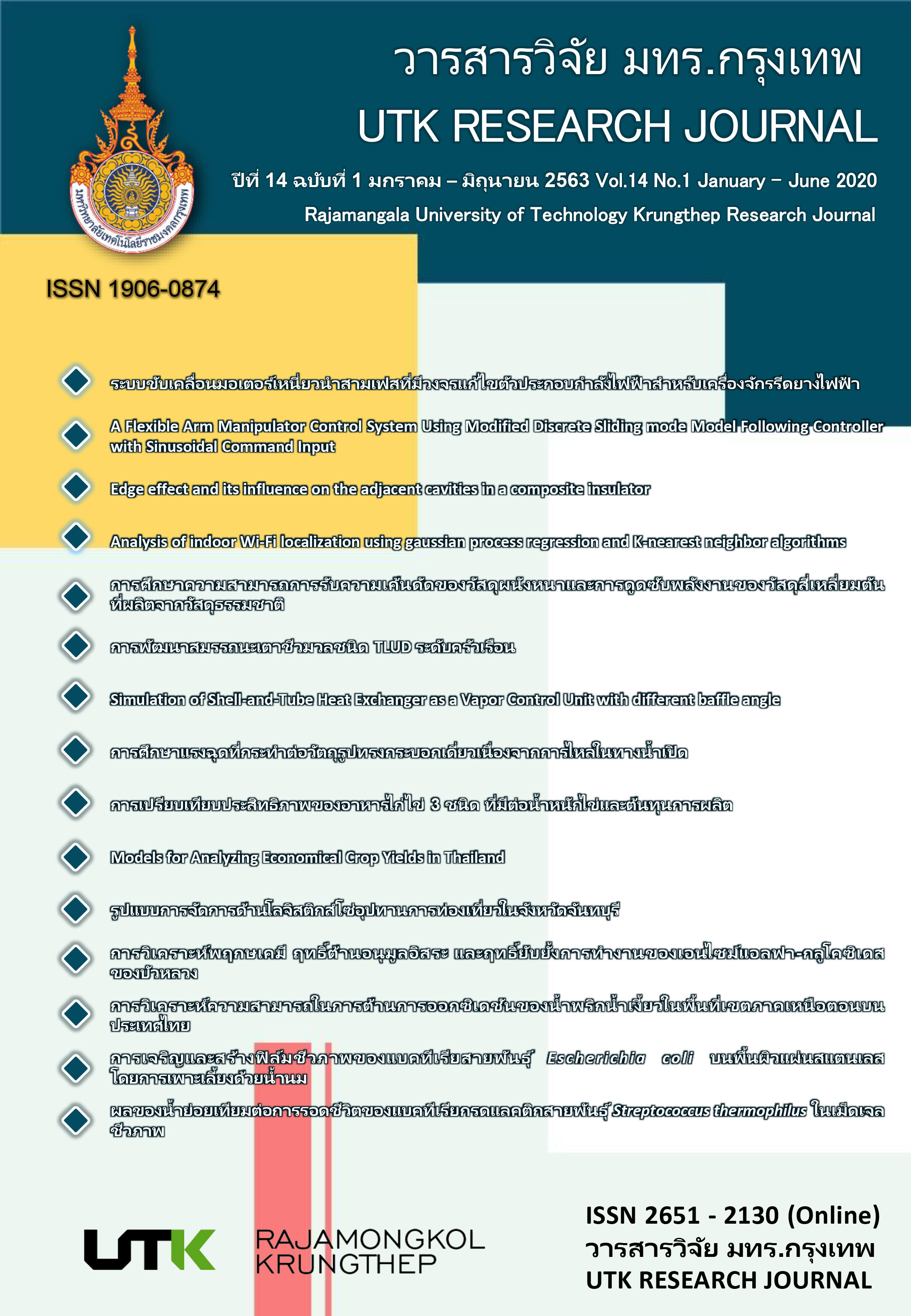การศึกษาแรงฉุดที่กระทำต่อวัตถุรูปทรงกระบอกเดี่ยวเนื่องจากการไหลในทางน้ำเปิด
คำสำคัญ:
แรงฉุด, สัมประสิทธิ์แรงฉุด, แรงพลศาสตร์, แรงชลพลศาสตร์, แรงเนื่องจากการไหลบทคัดย่อ
การศึกษาในครั้งนี้มีวัตถุประสงค์เพื่อหาพฤติกรรมของแรงฉุดเนื่องจากการไหลในทางน้ำเปิดผ่านวัตถุรูปทรงกระบอกเดี่ยวที่อยู่ในแนวดิ่ง ในการศึกษาจะดำเนินการจำลองสภาพการไหลผ่านวัตถุรูปทรงกระบอกเดี่ยวที่สร้างจากพลาสติกแผ่นบางที่มีพื้นผิวเรียบ และมีหน้าตัดแตกต่างกันจำนวน 4 หน้าตัด แรงฉุดที่เกิดขึ้นจริงจะถูกหาได้จากการทดลองโดยใช้หลักการสมดุลของโมเมนต์เนื่องจากแรงฉุดที่กระทำต่อวัตถุที่จมอยู่ใต้น้ำและโมเมนต์ต้านทานการหมุนของวัตถุที่ทำให้วัตถุสามารถตั้งตรงอยู่ในแนวดิ่ง สมมติฐานที่ใช้ในการศึกษาครั้งนี้ คือ การกระจายของแรงฉุดจะมีค่าสม่ำเสมอทั่วทั้งพื้นที่ของวัตถุที่จมอยู่ใต้น้ำ ค่าแรงฉุดที่เกิดขึ้นจริงที่ได้จากการทดลองจะถูกนำไปเปรียบเทียบกับแรงฉุดที่คำนวณได้ในทางทฤษฎีเพื่อหาค่าสัมประสิทธิ์แรงฉุด จากการศึกษาในช่วงการไหลที่มี 60,000 £ Re £ 210,000 จะพบว่าแรงฉุดที่กระทำต่อวัตถุทรงกระบอกแต่ละหน้าตัดจะแปรผันโดยตรงกับตัวเลขเรย์โนลด์ของการไหลผ่านวัตถุ ค่าสัมประสิทธิ์แรงฉุดที่ได้จะมีค่าค่อนข้างใกล้เคียงกันโดยมีแนวโน้มลดลงเพียงเล็กน้อย ค่าเฉลี่ยของสัมประสิทธิ์ของแรงฉุดที่ได้จะมีค่าเท่ากับ 1.977, 1.747, 1.552 และ 1.209 สำหรับวัตถุรูปทรงกระบอกหน้าตัดสี่เหลี่ยมมุมฉาก สี่เหลี่ยมคางหมู สามเหลี่ยมด้านเท่า และวงกลม ตามลำดับ ผลการศึกษาที่ได้ยังสามารถนำไปพัฒนาเป็นสูตรอย่างง่ายเพื่อหาหน่วยแรงฉุดบนพื้นผิววัตถุที่จมอยู่ใต้น้ำ ซึ่งสามารถใช้คำนวณหาแรงฉุดที่กระทำต่อวัตถุรูปทรงกระบอกสำหรับสภาพเงื่อนไขเช่นเดียวกับการศึกษาในครั้งนี้
เอกสารอ้างอิง
U.S. Department of Transportation Federal Highway Administration. Hydrodynamic forces on inundated bridge decks. Publication No. FHWA-HRT-09-028. 1st ed. McLean; 2009.
Fox RW, McDonald AT. Introduction to fluid mechanics. 5th ed. New York: John Wiley and Sons; 1999.
Daugherty RL, Franzini JB.Fluid mechanics with engineering applications. 7thed. Singapore: McGraw-Hill International Book Company; 1984.
Streeter VL, Wylie EB. Fluid mechanics. 1st ed. Toronto: McGraw-Hill International Book Company; 1981.
Bouak F, Lemnay J. Passive control of the aerodynamic forces acting on circular cylinder. Fluid Sci. 1998; 16: 112-21.
Tsutsui T, Igarashi T. Drag reduction of a circular cylinder in an air-stream. J Wind Eng Ind Aerod. 2002; 90(4-5): 527-41.
Chairul I, Lutfi M, Basuki W, et al. Mathematical modeling of drag coefficient reduction in circular cylinder using two passive controls at Re = 1000. Journal of Mathematical and Computation Application. 2018; 23(2):1-8.
Chairul I, Basuki W, Tri YY. Reduction of Cd in circular cylinder using two passive controls at Re = 1000 and 5000. J Phys : Conference Series. 2018; 974(1):1-9.
Aiba S, Watanabe H. Flow characteristics of a bluff body cut from a circular cylinders. J Fluid Eng. 1997; 119(2):453-4.
Achenbach E. Influence of surface roughness on the cross-flow around a circular cylinder. J Fluid Mech. 1971; 46(2):321-35.
Nakamura Y, Tomonari Y. The effects of surface roughness on the flow pass circular cylinders at high Reynolds numbers. J Fluid Mech. 1982; 123:363-8.
Bearman PW, Harvey JK. Control of circular cylinder flow by the use of dimples. AIAA Journal. 1993; 31 (10):1753-6.
Kimura T, Tsutahara M. Fluid dynamic effects of grooves on circular cylinder surface. AIAA Journal. 1991; 29(12):2062-8.
Huang S, Clelland D, Day S, et al. drag reduction of deepwater risers by the use of helical groovers. ASME 2007 26th International Conference on Offshore Mechanics and Arctic Engineering: 2007 June 10–15; San Diego, California, USA . ASME; 2007. 1. P.561-5.
Bo Z, Xikun W, Wie MG, et al. Force and flow characteristics of circular cylinder with uniform surface roughness at subcritical Reynolds numbers. Journal of Applied Ocean Research. 2015; 49: 20-6.
Monalisa M, Kurmar A. Study on drag coefficient for the flow past a cylinder. Int J Civ Eng Res. 2014; 5: 301-6.
ดาวน์โหลด
เผยแพร่แล้ว
รูปแบบการอ้างอิง
ฉบับ
ประเภทบทความ
สัญญาอนุญาต
กองบรรณาธิการวารสารวิชาการ มหาวิทยาลัยเทคโนโลยีราชมงคลกรุงเทพ มีความยินดีที่จะรับบทความจากอาจารย์ นักวิจัย นักวิชาการทั้งภายในและภายนอกมหาวิทยาลัย ในสาขาวิชาวิทยาศาสตร์และเทคโนโลยี ได้แก่ สาขาวิชาวิทยาศาสตร์ วิศวกรรมศาสตร์ และสาขาอื่นๆ ที่เกี่ยวข้อง รวมถึงสาขาต่างๆ ที่มีการบูรณาการข้ามศาสตร์ที่เกี่ยวข้องวิทยาศาสตร์และเทคโนโลยี ที่เขียนเป็นภาษาไทยหรือภาษาอังกฤษ ซึ่งผลงานวิชาการที่ส่งมาขอตีพิมพ์ต้องไม่เคยเผยแพร่ในสิ่งพิมพ์อื่นใดมาก่อน และต้องไม่อยู่ในระหว่างการพิจารณาของวารสารอื่น
การละเมิดลิขสิทธิ์ถือเป็นความรับผิดชอบของผู้ส่งบทความโดยตรง บทความที่ได้รับการตีพิมพ์ต้องผ่านการพิจารณากลั่นกรองคุณภาพจากผู้ทรงคุณวุฒิและได้รับความเห็นชอบจากกองบรรณาธิการ
ข้อความที่ปรากฏอยู่ในแต่ละบทความที่ตีพิมพ์ในวารสารวิชาการเล่มนี้ เป็นความคิดเห็นส่วนตัวของผู้เขียนแต่ละท่าน ไม่เกี่ยวข้องกับมหาวิทยาลัยเทคโนโลยีราชมงคลกรุงเทพแต่อย่างใด ความรับผิดชอบด้านเนื้อหาและการตรวจร่างบทความแต่ละบทความเป็นของผู้เขียนแต่ละท่าน หากมีความผิดพลาดใดๆ ผู้เขียนแต่ละท่านจะต้องรับผิดชอบบทความของตนเองแต่ผู้เดียว
กองบรรณาธิการขอสงวนสิทธิ์มิให้นำเนื้อหา หรือข้อคิดเห็นใดๆ ของบทความในวารสารวิชาการ มหาวิทยาลัยเทคโนโลยีราชมงคลกรุงเทพ ไปเผยแพร่ก่อนได้รับอนุญาตจากกองบรรณาธิการ อย่างเป็นลายลักษณ์อักษร ผลงานที่ได้รับการตีพิมพ์ถือเป็นลิขสิทธิ์ของวารสาร






